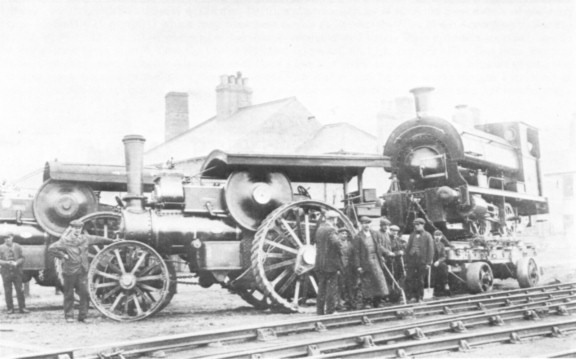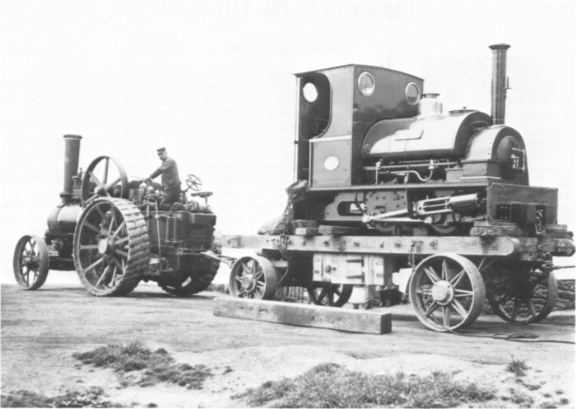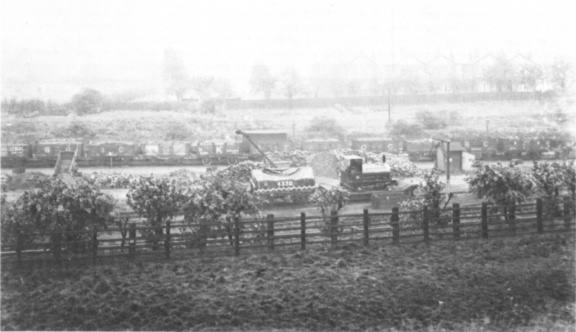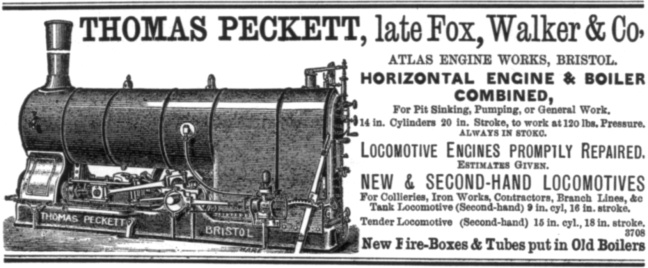
| THE INDUSTRIAL RAILWAY RECORD |
© APRIL 1974 |
PECKETTS IN TRANSIT
ROGER E. WEST
It is probable that most industrial locomotives delivered for use in this country have been despatched on their own wheels by rail, and with coupling and connecting rods removed and a little care and consideration from railway staff, the goods train of the day usually sufficed as a means of haulage. But this was not always the case and the accompanying photographs show three Peckett locomotives being delivered under different circumstances.

The first illustration, from the Society Collection per Frank Jones, shows Peckett 1180 of 1912, purchased new by Charlaw & Sacriston Collieries Co Ltd in County Durham, and presumably pictured on its arrival at Sacriston Colliery. The loco was doubtless delivered to the area by rail, and the two rather fine Fowler road locomotives seem to have been employed on the final stage of the journey by road, thus avoiding the inclines leading up to the colliery from Pelton Fell. Peckett 1180 was of the 15in cylindered Class E, weighing some 30 tons when "dry", so the second Fowler would have been quite necessary in the hilly neighbourhood. JESMOND (Fowler 8473 of 1900), attached to the Fowler built haulage bogie, was owned by Wm. Bland of Gosforth, Northumberland. He presumably also owned ALICE (Fowler 8192) in the background. A different photograph, taken without the camera or the locos being moved but with the workmen re‑posed, shows an inclined ramp constructed to bogie height at the right of the scene for the unloading of the engine.

The original illustration of GAMECOCK appeared in Peckett's advertising literature of the 1930's over the caption "small locomotive taken to destination by road". GAMECOCK (Peckett 1030 of 1904) had 7in by 10in cylinders and was one of the maker's "Class 7in" - though this covered a number of designs. Another Fowler - this time a general purpose engine - provides the motive power for the journey. Being of narrow gauge - 2ft 0in - loading on to a wagon would have been necessary for either road or rail transit. However, the purchasers were the Mendip Granite & Asphalt Co Ltd and it was presumably more economical to use road transport for the twenty or so miles from Bristol to their Cranmore Quarries, near Shepton Mallet. One must remember that most narrow gauge locomotives, when delivered by rail, would need transhipment to horse drawn or traction engine hauled wagons. At the time when narrow gauge railways were in vogue total shipment by road was out of the question for any but the shortest journeys.

The final illustration is from the collection of Frank Jones and has remained unidentified for some time. The locomotive is clearly a narrow gauge Peckett and initial inspection suggests a three foot gauge engine with 7in cylinders. Closer scrutiny of the background, particularly the wagons and houses, suggests Lancashire or Cheshire as the location. Mock half-timbered houses constructed in Edwardian/Victorian times were very popular in Cheshire and the Manchester area: wagons lettered "GC" make the date after 1st August 1897, and the presence of a two‑wheel coal cart in the yard to the left of the picture suggests a date no later than the mid‑1920's. The locomotive looks very crisp and would seem to be new rather than repaired, so, ignoring export orders (which would have been crated even if shipped from a northern port), the candidates are fairly few. Manchester Corporation Rivers Department acquired for their Davyhulme Sewage Works four 0‑4‑0 saddle tanks from Peckett in 1907 and a further example in 1914. These were 7in cylindered locomotives and of 3ft 0in gauge. I would suggest that the later locomotive, MOSTON (Peckett 1384 of 1914), is the subject of the photograph, the safety valves being of Peckett's later pop variety then in vogue, with the lower flat topped brass cover. Can any reader confirm or refute this assumption and further identify the location? Is the goods yard Flixton or Urmston on the Cheshire Lines Manchester to Liverpool line?
(The reverse of the print used for the last illustration is covered with deductive comments from the author. One of them is "Leaves on trees - therefore about May to September". Peckett's Boiler Records show that 1384 was despatched new to Manchester Corporation, Davyhulme, Urmston, near Manchester, on 5th September 1914. The use of "Urmston" in the address may indicate that the goods yard in the illustration is in fact Urmston as suggested. - KPP)
One of Peckett's less well-known products featured in their advertisement in "Engineering" for 7th April 1882, and a copy has been kindly provided by Ralph Martin. In "The West Somerset Mineral Railway" by Roger Sellick (David & Charles, 1970), a contribution by M.H. Jones gives details of one such engine (Peckett 421 of 1881) which may have seen service at Gupworthy New Mine. According to Society records, Peckett 421 was a semi-portable horizontal engine with 14in by 20in cylinders supplied new to the Ebbw Vale Steel, Iron & Coal Co Ltd at Watchet, Somerset, on 19th January 1881. Our Hon. Records Officer comments that Peckett's seemingly only built a few stationary engines, but it is difficult to establish just how many because of the blank numbers in the Fox Walker and Peckett works number lists: most of these are genuine blanks but some could have been for un‑recorded stationary engines or other machinery.
